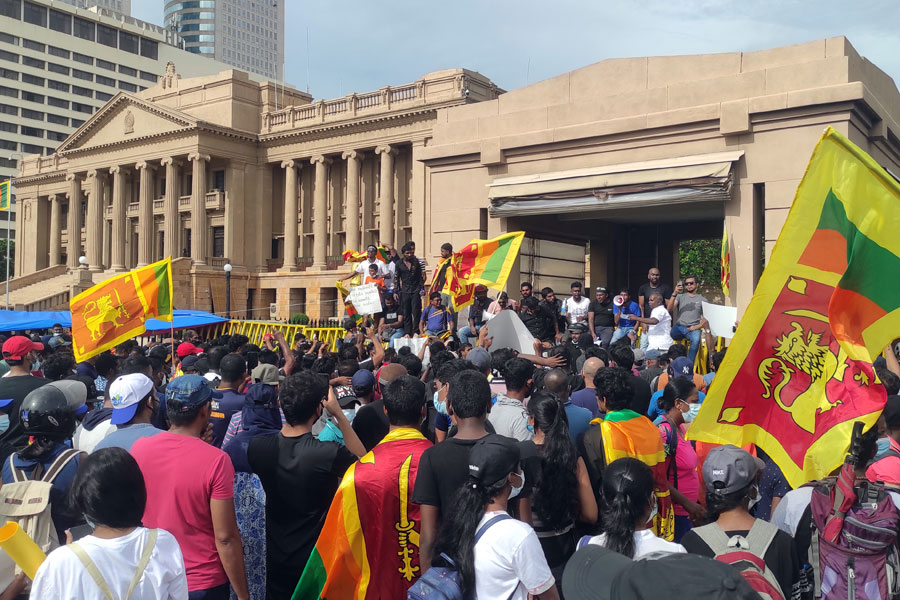by TCG Staff
Nebraska Democrats and their allies in the “mainstream press” are regularly promoting the “green” agenda, but they have apparently little regard for its unintended consequences. For that reason, many Cornhusker State readers were perhaps perplexed at the recent riots that resulted in the resignations of the Sri Lankan President and Prime Minister and the sacking of their residences after those officials fled.
The following article by Michael Shellenberger explains the role of the “green” agenda in the fall of Sri Lanka and, by implication, why Nebraska should reject it.
Green Dogma Behind Fall Of Sri Lanka
Organic farm advocates said they wanted what’s best for the 22 million people of the island nation off the coast of India. What went wrong?
Michael Shellenberger • July 9, 2022
Sri Lanka has fallen. Protesters breached the official residences of Sri Lanka’s Prime Minister and President, who have fled to undisclosed locations out of fear of death. The proximate reason is that the nation is bankrupt, suffering its worst financial crisis in decades. Millions are struggling to purchase food, medicine and fuel. Energy shortages and inflation were major factors behind the crisis. Inflation in June in Sri Lanka was over 50%. Food prices rose by 80%. And a half-million people fell into poverty over the last year.
The biggest and main problem causing Sri Lanka’s fall was its ban on chemical fertilizers in April 2021.
But the underlying reason for the fall of Sri Lanka is that its leaders fell under the spell of Western green elites peddling organic agriculture and “ESG,” which refers to investments made following supposedly higher Environmental, Social, and Governance criteria. Sri Lanka has a near-perfect ESG score (98) which is higher than Sweden (96) or the United States (51).
To be sure, there were other factors behind Sri Lanka’s fall. Covid lockdowns and a 2019 bombing hurt tourism, a $3 billion to 5 billion-per-year industry. Sri Lanka’s leaders insisted on paying China back for various “Belt and Road” infrastructure projects when other nations refused to do so. Sri Lanka racked up a huge foreign debt. Growth had been declining since 2012. And higher oil prices meant transportation prices rose 128% since May.
One-third of Sri Lanka’s farm lands were dormant in 2021 due to the fertilizer ban. Over 90% of Sri Lanka’s farmers had used chemical fertilizers before they were banned. After they were banned, an astonishing 85% experienced crop losses. The numbers are shocking. After the fertilizer ban, rice production fell 20% and prices skyrocketed 50 percent in just six months.
But the biggest and main problem causing Sri Lanka’s fall was its ban on chemical fertilizers in April 2021. Many other developing nations had to deal with similar challenges, including covid and high foreign debt, but have not collapsed. Indonesia has suffered terrorist bombings, which harmed tourism, but managed to rebound, and tourism rebounded in Sri Lanka starting last year. And while economic growth declined after 2012 but from astronomical peaks of 8% and 9% and remained above 3% and 4% until 2020.
The numbers are shocking. One-third of Sri Lanka’s farm lands were dormant in 2021 due to the fertilizer ban. Over 90% of Sri Lanka’s farmers had used chemical fertilizers before they were banned. After they were banned, an astonishing 85% experienced crop losses. The numbers are shocking. After the fertilizer ban, rice production fell 20% and prices skyrocketed 50 percent in just six months. Sri Lanka had to import $450 million worth of rice despite having been self-sufficient in the grain just months earlier. The price of carrots and tomatoes rose five-fold. While there are just 2 million farmers in Sri Lanka, 15 million of the country’s 22 million people are directly or indirectly dependent on farming.
Things were worse for smaller farmers. In the Rajanganaya region, where the majority farmers operate just a hectare (2.5 acres), families reported 50% to 60% reductions in crop harvest. “Before the ban, this was one of the biggest markets in the country, with tonnes and tonnes of rice and vegetables,” said one farmer earlier this year. “But after the ban, it became almost zero. If you talk to the rice mills, they don’t have any stock because people’s harvest dropped so much. The income of this whole community has dropped to an extremely low level.” Read the whole article here
Featured image by AntanO - Own work, CC BY-SA 4.0, https://commons.wikimedia.org/w/index.php?curid=116857384




